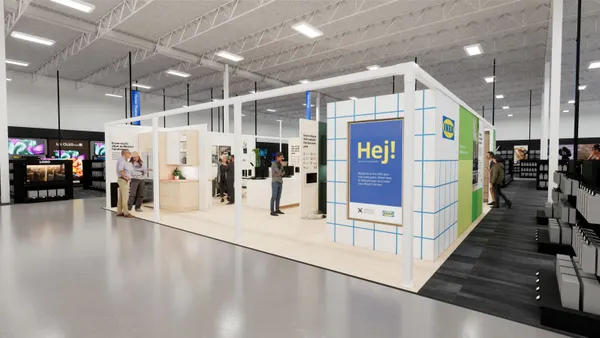There is something about the holiday season that can unexpectedly turn all of us into sentimental mush. We are going about our daily routine and a commercial catches our eye — maybe it is for a hoodie, or a department store or even one that focuses on package delivery — and we find ourselves fighting back tears.
The feeling that is evoked is one of nostalgia, or a yearning for a warmer, simpler time. It's the bittersweet emotion that is often equated with remembering the "good old days," time spent with family and a cozy sense of belonging.
"I think the expression is 'looking through rose-colored glasses,'" explained Michael Solomon, professor of marketing at Saint Joseph's University, who stated that around 10% of marketing today has some sort of nostalgic appeal. It is about an "ideal of an intimate, tight-knit community, you know with local stores that people are kind of missing today."
Retailers often tap into that notion for marketing efforts in the fourth quarter. Building a holiday strategy around nostalgia can help create a bond with shoppers. "Nostalgia is always a hook in marketing in general, but in retail you can bring it to life as far as how you actually get that product to the customer and pique their interest through the process," said Ryan Fisher, partner in the consumer and retail practice at A.T. Kearney.
Nostalgia and community
Nostalgia works because it is tied to a sense of belonging. "One of the main motivations for shopping is to recreate or create a sense of community," Solomon said. "It's all about feeling that you have a connection, whether it's online or offline." The way retailers can tap into that motivation is by creating a space where a shopper feels as though they are recognized. "That's the ideal that people I think are trying to recapture," he said, but added, "I think many of them have never experienced it at all."
Macy's 2019 holiday campaign taps into that sense of neighborly inclusion, where people are seen and known. In the department store's recent commercial, "Santa Girl," a young girl, Virginia, dreams of becoming Santa when she grows up. Her classmates make fun of her and one boy says that she can't become Santa because she's a girl. Her parents cover their truck with lights and she goes throughout the neighborhood and delivers gifts — even to the boy who made fun of her.
The commercial hits on a number of enduring concepts that are revisited during the season. Family. Forgiveness. Community. The name Virginia is possibly a sweet nod to the infamous New York "Sun" editorial where a girl wrote in asking if Santa was real and received the response of, "Yes, Virginia, there is a Santa Claus." It is also self-referential, with the iconic entrance of Santa Claus at the end of every Macy's Thanksgiving Day Parade.
In a similar way, Amazon's 2019 holiday ad emphasizes family, connection and warmth. The audience sees the e-retailer's branded boxes in different locations, while everyone (including the boxes) sings, "Everybody Needs Somebody to Love."
"Nostalgia works because it connects with shoppers at a fundamentally emotional level," said Sara Al-Tukhaim, senior vice president of global retail insights at Kantar Consulting. "For this very reason, it is sticky and it sticks year over year because it taps into what makes shoppers feel good: fond memories of the past, time with those we care about, and the rituals and traditions that we pass down and on."
Nostalgia, Gen Z and millennials
Can nostalgia work on a younger generation? As a general rule, it tends to sway an older audience with more shared experiences, but younger shoppers can experience similar feelings from its use, even if they aren't recognized as nostalgia.
According to Solomon, Gen Z has already been exposed to so many trends that longing for a thing from the past is still relevant, because styles have changed in such short spurts. "The fast-fashion cycle is so much faster that even kids have experienced it and have seen a lot of things come and go," he said.
But Tim Barlow, senior principal analyst at Gartner, posits that the definition of nostalgia has begun to shift over the last five to 10 years. According to his research, nostalgia is becoming more centered around ideas of serenity, relaxation and a childlike freedom from worry. "All of this sort of underscores a broader consumer desire to cocoon in some way," Barlow said. As the world is in a current state of prolonged unpredictability, "it makes sense that people would sort of retreat into a comfort of the known and that nostalgia play can be a great way to do that."
Additionally, "the good old days" weren't good at all for entire swaths of our country. "Going backwards in time isn't appealing for everybody," Barlow said. "So, how can we offer these things to the consumers who like them, but also bring in new consumers who maybe didn't find those times particularly relaxing or simplistic or serene the first go around?"
Millennials in particular link nostalgia with a very specific time — the '90s. It was pre-9/11. It was pre-Great Recession. It was before the mass proliferation of mobile technology. And the memory of that decade can be related to feelings of hope and optimism. "What we've realized through our research is that the reason for that is that the '90s remains sort of this idyllic place. For a certain group of consumers, it's really fun to go back and visit because life hasn't really been the same since," Barlow said.
The association between yearning for simplicity and wanting a small connection to the past may play a role in the proliferation of pop-ups during the holiday season. Barlow asserts that consumers don't want to continue to live in the past. Instead, they want a reminder of a different time in life, and that may be tied to curated assortments of goods that invoke nostalgic feelings. "It gives you some sense of, like, 'The world wasn't always like it is right now. And maybe we can go back to that in some sense.' I think from a retailer perspective, there's the temporary nature. I think that's why you see pop-ups being so successful," he said.
Macy's Story concept plays with nostalgic ideas through its "Home for the Holidays" installation and Kohl's is launching a temporary event in New York City that features holiday treats and a curated assortment of products for purchase. Even Birchbox can be found at 500 Walgreens locations this season.
Translating nostalgia online
Nostalgia can be evoked through advertising, in-store merchandising or even via curated product selection. But, is it even possible to evoke those strong emotions through online shopping?
"At its heart, online shopping is a solitary experience," said Solomon. "What we have now is simulating the experience of going with friends or family to stores." For shoppers sitting behind a computer or phone, a connected experience may be replicated through Instagram or other platforms, giving users "some kind of reference material or feedback as opposed to just making choices, sitting in your bedroom at three in the morning."
Kantar Consulting's Al-Tukhaim agrees that part of the answer with how to elicit powerful emotions outside of a brick-and-mortar setting is social media. "Online space offers so many more flexible platforms for drawing out solutions and incentives tied to nostalgic themes that would not be as possible in a physical store," she said in an email to Retail Dive. Social media is then, "[p]robably the strongest platform for users to connect to and convey what's nostalgic to them in a meaningful way and the ability to bridge the social media opportunity with the commercial online experience is significant."
A.T. Kearney's Fisher, though, thinks that retailers haven't quite made robust connections through the online experience. Specifically, stores haven't altogether figured out how to translate a nostalgic marketing campaign to an online experience. "Many times you click on the link to go to that retailer, and it's just the same old page that doesn't even link to what that marketing campaign is about," he explained. Just as retailers would integrate a merchandising plan in a brick-and-mortar environment, those efforts need to carry through a web experience. "How do you do that in an online environment and adapt your online websites and search capability to provide that type of experience for the customer?" he asked.
Retailers fumbling to present a powerful connection between the online and offline worlds may account for why the majority of consumers are planning to shop in physical locations this season. According to a recent report by The International Council of Shopping Centers, 90% of holiday shoppers expect to make purchases in stores. Gen Z even plans to participate in traditional shopping, with 55% stating that they will shop at brick-and-mortar stores.
Those retailers who start to make a deeper connection online may position themselves to pull out ahead.
"How do you remove yourself from being a transaction on a commodity to having a connection with the consumer?" Fisher asked. "Where the winners are going to be are those that can connect to experience."












